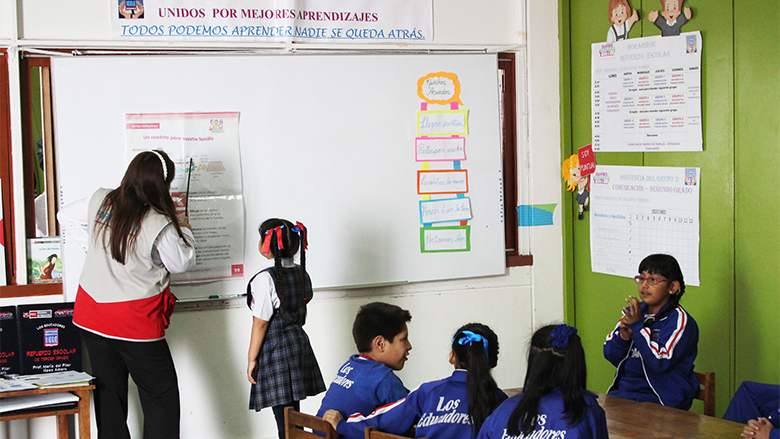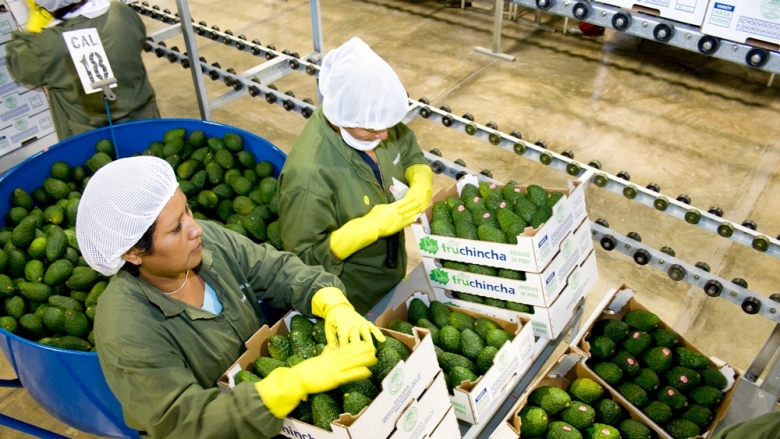Challenge
Peru grew at an average of 5.7 % per year from 2001 to 2013, compared to regional and global growth of around 3 %. This growth helped Peru reduce poverty from 55 % to 24 % of the population in the same period, faster than in other countries with similar income levels. Growth was the main driver of this reduction in poverty and inequality, accomplished primarily through improved labor incomes rather than redistribution policies. However, by 2014 growth had slowed to 2.4 %, as most emerging economies — including Peru — faced lower export demand from China and elsewhere, worsening terms of trade, and higher borrowing costs. Under this unfavorable external environment, by 2016 growth in Peru had to rely much more on productivity gains. Productivity had contributed to about a third of the country’s growth in the preceding years, but a large gap with high-income countries still remained.
Approach
With the Boosting Human Capital and Productivity Development Policy Financing with a Deferred Drawdown Option Project, the World Bank sought to support Peru in targeting key productivity constraints by enabling improvements in the quality of human capital, fostering competition pressures, and facilitating trade. A stand-alone development policy financing with a deferred drawdown option (DPF-DDO), Boosting Human Capital and Productivity was prepared to back Peru’s reform agenda, support the authorities’ medium-term financial plan, serve as a buffer to negative shocks, and foster policy dialogue with the new government. The hedging feature of the DDO, particularly in times of international capital market volatility, was highly valued by the authorities. With a presidential election in mid-2016, this instrument also signaled an ongoing commitment to policy reforms. This project focused on enhancing education policy; facilitating the entry, operation, and exit of firms; and reducing transaction costs of trade. Further, it supported policy and implementation continuity beyond the financing option for the incoming administration.
Results
The DPL-DDO supported adoption of legislation to enhance the effects of trade, competition, and education on productivity. Adoption of these polices led to the following key results:
- Reducing transaction costs in trade: The project supported reforms to simplify the customs regime and to complement other actions to increase the efficiency of customs proceedings. As a result, total time to release goods imports (TTLM) declined 49 % between 2014 and 2019. In addition, export competitiveness and access to markets were supported through two new organizations: the National System for Quality and the National Quality Institute (INACAL). Standards provided by INACAL have been relevant to the export success of several agro-industrial products, like asparagus and avocado.
- Facilitating the entry, operation, and exit of firms: The entry of firms was simplified with the operation of a digital intermediation system, known as Sistema de Intermediación Digital (SID), which has allowed firms to register online since 2014; the reform was deepened with the creation of a new type of firm (the simplified closed stock company or sociedad por acciones cerrada simplificada, SACS), for which basic firm constitution and the most important patrimonial acts can be completely done online. In addition, the competition authority (INDECOPI) was granted the mandate to promote entry into product and service markets, and more than seventeen thousand bureaucratic barriers were removed between 2014 and 2019. Backed by the program, business exit has been facilitated through the use of electronic auctions for asset foreclosures, a resource that has become increasingly prevalent in recent years as judiciary processes intensify its use.
- Enhancing the education policy framework to improve skill quality: To increase teaching quality, the project supported performance evaluations for principals and teachers. It also backed the full-school-day scheme, which added two hours of instruction to select public schools, increasing the PISA scores for math in 23 % of a standard deviation. Furthermore, the National Superintendency of High Education (SUNEDU), the country’s regulator of tertiary education quality, helped establish and review applications for institutional licensing for every university in Peru.

